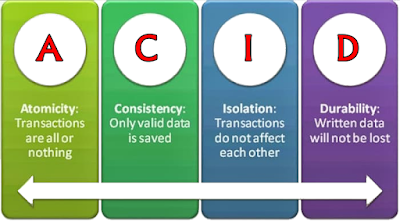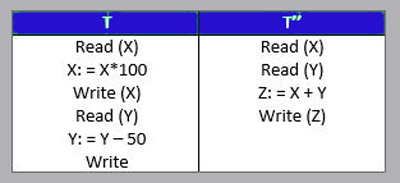Question: Explain ACID Properties of Transaction.
In computer science, ACID (atomicity, consistency, isolation, durability) is a set of properties of database transactions intended to guarantee validity even in the event of errors, power failures, etc.
What do you mean by transaction in DBMS?
A transaction is a single logical unit of work which accesses and possibly modifies the contents of a database. Transactions access data using read and write operations. In order to maintain consistency in a database, before and after the transaction, certain properties are followed. These are called ACID properties.
Atomicity:
- This property ensures that either all the operations of a transaction reflect in database or none. Let’s take an example of banking system to understand this: Suppose Account A has a balance of 400$ & B has 700$. Account A is transferring 100$ to Account B. This is a transaction that has two operations a) Debiting 100$ from A’s balance b) Creating 100$ to B’s balance. Let’s say first operation passed successfully while second failed, in this case A’s balance would be 300$ while B would be having 700$ instead of 800$. This is unacceptable in a banking system. Either the transaction should fail without executing any of the operation or it should process both the operations. The Atomicity property ensures that.
- Consider the following transaction T consisting of T1 and T2: Transfer of 100 from account X to account Y.
- If the transaction fails after completion of T1 but before completion of T2.( say, after write(X) but before write(Y)), then amount has been deducted from X but not added to Y. This results in an inconsistent database state. Therefore, the transaction must be executed in entirety in order to ensure correctness of database state.
Consistency:
- To preserve the consistency of database, the execution of transaction should take place in isolation (that means no other transaction should run concurrently when there is a transaction already running). For example account A is having a balance of 400$ and it is transferring 100$ to account B & C both. So we have two transactions here. Let’s say these transactions run concurrently and both the transactions read 400$ balance, in that case the final balance of A would be 300$ instead of 200$. This is wrong. If the transaction were to run in isolation then the second transaction would have read the correct balance 300$ (before debiting 100$) once the first transaction went successful.
- The total amount before and after the transaction must be maintained.
- Total before T occurs = 500 + 200 = 700.
- Total after T occurs = 400 + 300 = 700.
- Therefore, database is consistent. Inconsistency occurs in case T1 completes but T2 fails. As a result T is incomplete.
Isolation:
- For every pair of transactions, one transaction should start execution only when the other finished execution. I have already discussed the example of Isolation in the Consistency property above.
- Let X= 500, Y = 500.
- Consider two transactions T and T”.
- Suppose T has been executed till Read (Y) and then T’’ starts. As a result , interleaving of operations takes place due to which T’’ reads correct value of X but incorrect value of Y and sum computed by
- T’’: (X+Y = 50, 000+500=50, 500)
- is thus not consistent with the sum at end of transaction:
- T: (X+Y = 50, 000 + 450 = 50, 450).
- This results in database inconsistency, due to a loss of 50 units. Hence, transactions must take place in isolation and changes should be visible only after they have been made to the main memory.
Durability:
- Once a transaction completes successfully, the changes it has made into the database should be permanent even if there is a system failure. The recovery-management component of database systems ensures the durability of transaction.
The ACID properties, in totality, provide a mechanism to ensure correctness and consistency of a database in a way such that each transaction is a group of operations that acts a single unit, produces consistent results, acts in isolation from other operations and updates that it makes are durably stored.




